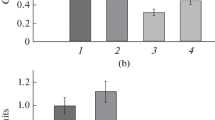As a result of the first session of intravenous laser irradiation of blood, it has been established that changes in the blood cellular elements, according to the data of cytometry, and in the blood and plasma viscosity are analogous to the changes occurring when a blood specimen is being incubated at a temperature of 48°C for 1 h or during its storage for 18 days at 12°C in a refrigerator: average dimensions of leukocytes decrease, thrombocytes decline in number, the deformability of erythrocytes is impaired, and the viscosity of the blood increases. Analogous changes in the cytometric and rheological indices, as well as a small hemolysis of eryth-rocytes, were observed on irradiation of a blood specimen in vitro. The suggestion has been made that the therapeutic effect of intravenous laser irradiation of blood is due to the generation of young cellular elements and their ejection into the blood channel instead of those damaged by the laser radiation.
Similar content being viewed by others
References
K. V. Popov, On the mechanisms underlying the realization of clinical effects of low-intensity laser therapy of ischemic heart disease, Byull. SO RANM, 117, No. 3, 21–25 (2005)
A. V. Volotovskaya, V. S. Ulashchik, and V. N. Filipovich, Antioxidant action and the therapeutic efficiency of laser irradiation of blood in patients with heart ischemia, Vopr. Kurort. Fizioter. Lecheb. Fizkult., No. 3, 22– 25 (2003).
V. A. Builin, Laser Reflexive Therapy with Application of "Kreolka" Apparatus [in Russian], Tekhnika-Pro, Moscow (2002).
A. N. Malov and M. G. Kostyuk, Model analysis of basic biological processes in low-intensity laser therapy, http://www.baikalnarobraz.ru/index.php?IdAction=docs&Event=read&id=106
X. Q. Mi, J. Y. Chen, and L. W. Zhou, Effect of low power laser irradiation on disconnecting the membrane-attached hemoglobin from erythrocyte membrane, J. Photochem. Photobiol. B, Feb 13; Electronic resource: [Epub ahead of print] "Elsevier."
K. R. Byrnes, R. W. Waynant, I. K. Ilev, X. Wu, L. Barna, K. Smith, R. Heckert, H. Gerst, and J. J. Anders, Light promotes regeneration and functional recovery and alters the immune response after spinal cord injury, Lasers Surg. Med., 36, No. 3, 171–185 (2005).
Yu. A. Vladimirov, G. I. Klebanov, G. G. Borisenko, and A. N. Osipov, Molecular-cell mechanisms of the action of low-intensity laser irradiation, Biofizika, 49, Issue 2, 339–350 (2004).
M. A. Nikulin and V. G. Kozlov, Influence of helium-neon laser radiation on blood in the experiment, in: Lasers and Medicine, Int. Conf., Volume of Abstracts [in Russian], Pt. 1, Tashkent (1989), pp. 123–124.
J. Kujawa, L. Zavodnik, I. Zavodnik, V. Buko, A. Lapshyna, and M. Bryszewska, Effect of low-intensity (3.75–25 J⁄cm2) near-infrared (810 nm) laser radiation on red blood cell ATPase activities and membrane structure, J. Clin. Laser Med. Surg., 22, No. 2, 111–117 (2004).
J. Kujawa, L. Zavodnik, I. Zavodnik, and M. Bryszewska, Low-intensity near-infrared laser radiation-induced changes of acetylcholinesterase activity of human erythrocytes, J. Clin. Laser Med. Surg., 21, No. 6, 351–355 (2003)
A. M. Moroz, Activity of the erythrocytic Na+-K+-ATPase after exposure to laser radiation, Ukr. Biokhim. Zh., 55, Issue 6, 674–676 (1983).
I. V. Yamaikina, Z. P. Shul’man, L. I. Ershova, Z. M. Likhovetskaya, and N. A. Gorbunova, New rheological model for analyzing the aggregatability and deformability of erythrocytes in a number of hematological pathologies, Inzh.-Fiz. Zh., 77, No. 2, 130–133 (2004).
I. V. Yamaikina and V. A. Mansurov, Microrheological state of erythrocytes: estimation of the deformability by the filtration method with the aid of an IDA-4 device, in: Heat- and Mass Transfer-2005, ITMO NAN Belarusi, Minsk (2005), pp. 215–218.
B. S. Bull and M. B. Zucker, Changes in platelet volume produced by temperature, metabolic inhibitors, and aggregating agents, Proc. Soc. Exp. Biol. Med., 120, No. 2, 296–301 (1965).
I. V. Yamaikina, V. A. Mansurov, and E . V. Ivashkevich, Termal denaturation of the spectrine of erythrocytes: rheology, deformability and detergent stability, Biofizika, 42, Issue 3, 675–679 (1997).
Author information
Authors and Affiliations
Additional information
Translated from Inzhenerno-Fizicheskii Zhurnal, Vol. 81, No. 6, pp. 1164–1169, November–December, 2008.
A. S. Podol’tsev: Deceesed
Rights and permissions
About this article
Cite this article
Yamaikina, I.V., Malashevich, P.N., Volkova, E.G. et al. Direct rheological, cytometric, and cardiological effect of intravenous laser irradiation of blood. J Eng Phys Thermophy 81, 1207–1213 (2008). https://doi.org/10.1007/s10891-009-0139-3
Received:
Revised:
Published:
Issue Date:
DOI: https://doi.org/10.1007/s10891-009-0139-3



